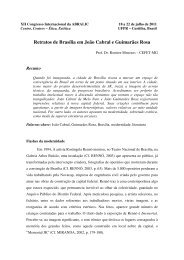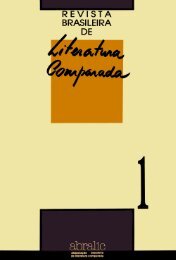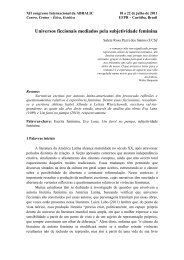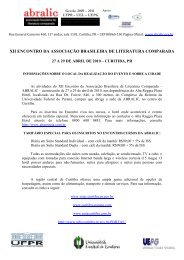download da revista completa (pdf - 9.225 Kb) - Abralic
download da revista completa (pdf - 9.225 Kb) - Abralic
download da revista completa (pdf - 9.225 Kb) - Abralic
You also want an ePaper? Increase the reach of your titles
YUMPU automatically turns print PDFs into web optimized ePapers that Google loves.
16 Revista Brasileira de Literatura Compara<strong>da</strong>, n° 3<br />
if the work of editing and translating in a field as important as that of the<br />
demotic texts is still in its initial stage, then the observation of any kind of<br />
historical development within Ancient Egyptian literature, due to such scarcity<br />
of sources, has a highly hypothetical status - and the reconstruction of<br />
any intertextual networks is perhaps simply impossible. Egyptologists are<br />
certainly aware of the consequences which this situation has for the status of<br />
their discourses - up to the point where such awareness has become a<br />
key-component in the intellectual identity of their discipline. This challenge<br />
coming from the discipline's precarious documentary basis is aggravated<br />
both by the lack of any meta-commentaries and concepts, within Ancient<br />
Egyptian culture, regarding the texts characterized as "literary", and by the<br />
fragmentary character of most of the textual sources that we possesso The<br />
state of the discipline's archive and the distance that separates us, on different<br />
leveIs, from Ancient Egypt confront the Egyptologist with hermeneutic challenges<br />
that could hardly be any tougher - and any more elementary. At the<br />
same time and for the same lack of centextualizing knowledge, the highest<br />
leveIs of hermeneutic sophistication often remain inaccessible for the Egyptologist.<br />
As long as it is unclear whether or not a specific textual passage must<br />
be read as a metaphor and whether another one is a euphemism for a sexual<br />
detail or a phrase without any sexual connotations, as long as the<br />
Egyptologist's task is often reduced to "translating what he does not understand",<br />
concerns like those, for example, of deconstruction or of critique<br />
génétique are quite secon<strong>da</strong>ry.<br />
Other limits and problems of Egyptology havc to do with the multiple<br />
writing systems which Ancient Egyptian culture developed and with the<br />
materiality ofthe media which it used. Given the strictly consonantic character<br />
of these writing systems, there is no hope for us to ever imagine the sound<br />
qualities of Ancient Egyptian texts, which of course makes particularly<br />
precarious the analysis and even the identification of lyrical texts. On the<br />
other hand, one may suppose that the role played by the form of graphemes<br />
in the construction of texts, including the constitution of their content, must<br />
have been quite different from the reduced importance typically attributed to<br />
graphemes within our - logocentric - western culture. But above all the<br />
multiplicity of the writing systems and of the material media belonging to<br />
Ancient Egyptian culture makes highly problematic the assumption that<br />
Ancient Egyptian literature constituted a unity. We know that, at least statistically,<br />
certain relationships of preference existed between determinate textual<br />
genres and the different writing systems (i.e. monumental hieroglyphs,<br />
cursive hieroglyphs, hieratic writing, and demotic writing). The picture becomes<br />
even more complex - and even more potentially heterogeneous - if<br />
one takes into account, as a third leveI of reference, the different materiaIs on<br />
which texts (in different letters) were written - such as walls, papyri, wood




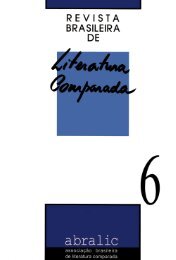
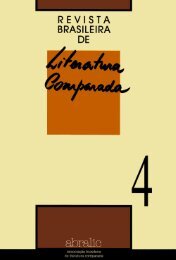
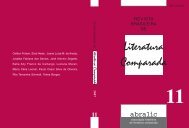
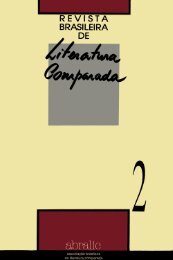
![Olhar Viajante, de Maria Lúcia Medeiros: [homo]erotismo ... - Abralic](https://img.yumpu.com/38407389/1/184x260/olhar-viajante-de-maria-lacia-medeiros-homoerotismo-abralic.jpg?quality=85)
